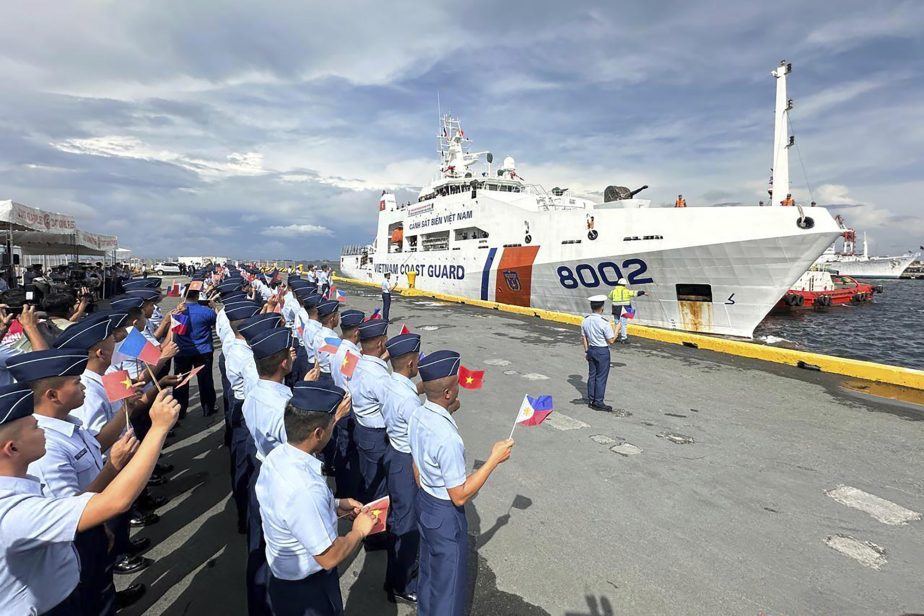In a significant step towards enhancing maritime cooperation, the coast guards of the Philippines and Vietnam are set to conduct their first-ever joint exercises on August 9. This collaboration comes at a crucial time as both nations seek to address rising tensions in the South China Sea, a disputed region with overlapping claims and ongoing confrontations with China.
Historic Maritime Exercises Begin
The Vietnamese coast guard ship, CSB 8002, arrived in Manila on Monday. It is 90 meters long and will work with the Philippines’ 83-meter patrol vessel, BRP Gabriela Silang, for five days. They will practice search and rescue and train for fires and explosions. This is the first time the two countries’ coast guards are working together like this.
The visit is part of a bigger plan to strengthen their maritime relationship. Rear Admiral Armand Balilo, a spokesperson for the Philippine Coast Guard, said these exercises show how two countries with disputes can work together. This visit follows an agreement made when Philippine President Ferdinand Marcos Jr. visited Hanoi in January.
Strengthening Bilateral Relations
The timing of these exercises is noteworthy. They come shortly after a leadership change in Vietnam. Vietnamese President To Lam has succeeded Nguyen Phu Trong as the General Secretary of the Communist Party. This transition adds a layer of significance to the exercises, as they occur amid a shifting political landscape in Hanoi.
During the visit, CSB 8002 will participate in various drills with BRP Gabriela Silang. These exercises aim to enhance skills in search and rescue operations and prepare for emergencies involving fires and explosions. The focus is on improving cooperation and sharing information to boost maritime law enforcement efforts.
Background of the South China Sea Dispute
The South China Sea is a hot spot with several countries, including the Philippines and Vietnam, claiming parts of it. China’s actions in the area have made things tense, especially around Second Thomas Shoal. This spot has seen clashes because China tried to block Philippine supply missions, leading to injuries among Filipino sailors.
Even though there’s a temporary deal for peaceful resupply missions, the main disagreement over Second Thomas Shoal and other areas continues. China’s Coast Guard has become more active and aggressive, making it clear that the region needs better cooperation among the countries involved.
Promoting Regional Security
The recent exercises reflect a growing trend of cooperation among Southeast Asian countries with claims in the South China Sea. Historically, these nations have faced challenges in forming a unified stance against China’s expansive claims due to their own overlapping territorial disputes.
Recent developments have seen enhanced collaboration between the Philippines and Vietnam. During a January state visit, President Marcos Jr. and Vietnamese leaders signed agreements to improve cooperation between their coast guards and to address incidents in the South China Sea. Marcos described Vietnam as a key strategic partner for the Philippines, emphasising the importance of maritime cooperation.
Future Prospects
In June, Vietnam expressed willingness to engage in talks with the Philippines to resolve overlapping claims in the South China Sea. This move came shortly after the Philippines requested formal recognition from the United Nations for its rights to the continental shelf extending into the South China Sea. The overlapping claims highlight the complexity of the dispute and the need for ongoing dialogue.
The Vietnamese goodwill visit and joint exercises are seen as positive steps towards enhancing cooperation despite existing disputes. The focus on shared interests and mutual benefits demonstrates a commitment to regional stability and security.
Way Forward
The upcoming joint exercises between the coast guards of the Philippines and Vietnam show important progress in working together on the sea. These drills help both countries deal with the problems in the South China Sea. They also strengthen their relationship and make the region safer. This teamwork is a good example of how countries with disputes can join forces to tackle shared challenges.

